Mexicans rush to see the relics of Saint Jude, the ‘most miraculous’ saint
Thousands of people are lining up to visit the patron saint of impossible causes. They ask him for better health, work opportunities and help resolving problems with the law
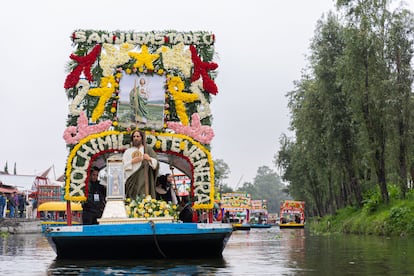

“This saint is very miraculous,” says Doña Angela, 66, holding a holy card with the image of Saint Jude Thaddeus. She has come from Aguascalientes to Xochimilco, south of Mexico City, to visit the saint’s relic. She and her sister Isabel, 63, have traveled 310 miles by bus in the hope that Saint Jude will hear their prayers. The saint is thought to help with “impossible causes,” be it due to health, work or problems with the law. Isabel says that Covid-19 left one of her brothers bedridden, unable to speak or move. “They said he wouldn’t live more than three months, but three years have passed, and he is still with us,” she says. “I ask Saint Jude every day to restore his health and return him to us. We have not lost our faith,” she says.
Mexico is a country of crowds, bustling streets and big events. This is seen at concerts, at rallies in public squares and games at the Azteca Stadium. But if there is something that is attracting even larger numbers, it’s Saint Jude: millions of people have waited under the sun or the rain to see the relic of the apostle. “Our country is going through very difficult situations of violence and insecurity, where the most affected are the poor and the most marginalized sectors of society,” says the priest Jesús Alejandro Ortega, vice-rector of the San José seminary. “The people identify with Saint Jude because he is the saint of hopeless causes, through him, they put their needs in the hands of God and faith rebuilds their hope.”
The cult began in Chicago, when a Claretian priest instituted Saint Jude Thaddeus as the patron of the city’s police. That same priest, in the 1950s, brought the image of the saint to the Claretians, who ran the church of San Hipólito in Mexico City. “Saint Jude has a connection with the humblest people in Mexico. He is an approachable and simple saint,” says Alejandro Ortega. Honest or dishonest, hard-working or evildoers, everyone wants to visit the saint. It is believed that Saint Jude helps seemingly lost causes.
The relic is inside a polychrome wood carving from the 19th century. It is in the shape of a forearm and hand, which has three fingers pointing upwards, as a sign of blessing. The piece of arm bone believed to belong to the apostle is behind a glass cover within the forearm. The relic is usually kept in the church of San Salvatore in Lauro, in Rome. Last July, it was brought by the Vatican nunciature to Mexico to “restore hope to the faithful after the pandemic,” according to a statement shared with the media. “After the Virgin of Guadalupe, in Mexico there is a great devotion to Saint Jude Thaddeus,” says Gina Gil, who oversaw the relic’s trip to Mexico.
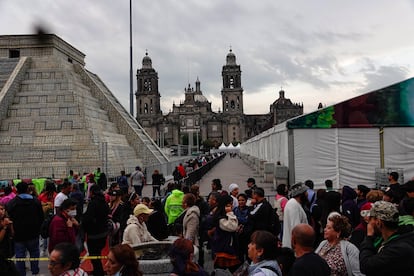
Mile-long queues of people wait in front of the Metropolitan Cathedral for a chance to see the relic: authorities in Xochimilco say more than 180,000 visitors can arrive in a single day. By 9:00 a.m., the line outside already stretched for several blocks. Be it in a wealthy or poor neighborhood, a big or small one, every San Judas procession has been a hit
The relic is doing a tour that Taylor Swift and Bruno Mars would have loved, traveling to Mexico City, Mexico State, Tlaxcala and Puebla in August. Each and every stop is packed. The devotion inspired by the relic is so great that altars have been built everywhere: it is very common to find images of Saint Jude in markets, taxi stands, taco shops or in parks.
Some people have been waiting in front of the Cathedral since 3 a.m., others resign themselves to waiting until the church closes its doors at night. “My sister has just come out of a very delicate surgery, and I am asking him to get rid of her illness and bring health to everyone,” explains Tomás Olguín, 55. He has come from the Miguel Hidalgo municipality with his wife and his mother-in-law in a wheelchair. “Having the relic here in Xochimilco is a miracle,” he says enthusiastically, adding that he and his family celebrate the saint’s day, every 28th of each month. “On the 28th, we go to Mass, or we light a candle. On October 28th we usually go to the San Hipólito church, in the historic center, for its big party,” he adds.
A line of people enters a chapel on one side of the altar. With their cell phones held high and their eyes wide open, many murmur their prayers as they walk. “Please, brothers, do not stop. We recommend that you make a video with your cell phone and do not take photos so that the visit goes faster,” says the logistics staff. The bone is placed next to a life-size wax statue. The tour lasts barely a minute. But it’s enough to make the visitors happy. Sick people, the elderly, children, and young people flock to see the relic.
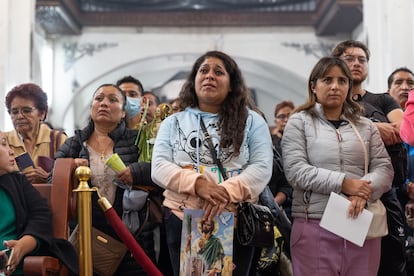

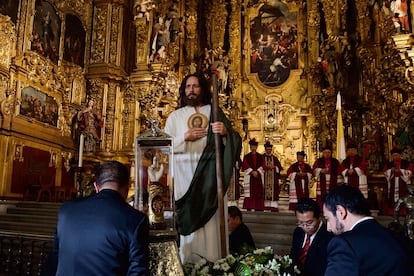

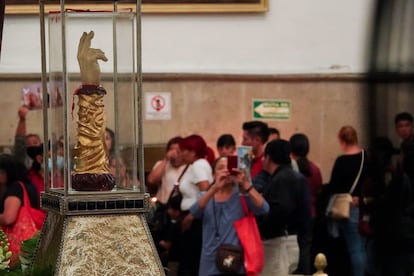
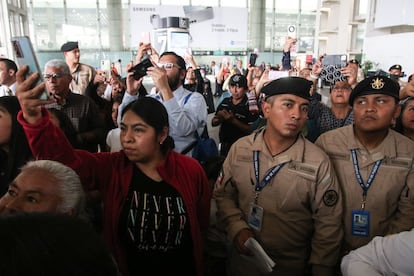
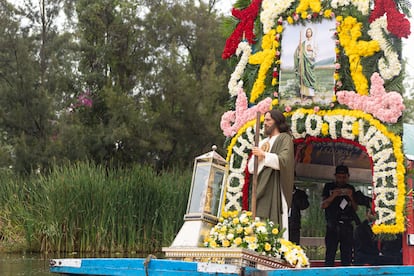


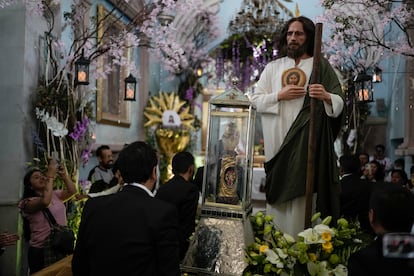
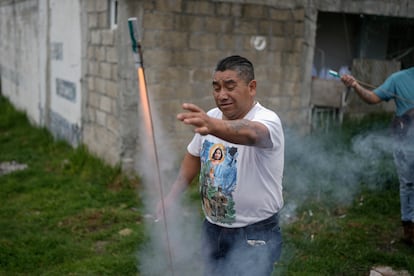


Father Ortega blesses T-shirts, candles and rosaries that people have just bought at a souvenir stand at the exit of the chapel, where the relic is on display. On the tour, the relic is moved in a special glass-enclosed urn “so that all the devotees can see it as they pass by,” the nunciature says. That morning in Xochimilco, they also held a procession in a trajinera — a type of flat-bottomed boat — which sailed through the canals and chinampas.
Veneration for the patron saint of impossible causes goes beyond the borders of Mexico. In fact, there are two other relics of the arm of Saint Jude in the United States. One of them is also on tour, and will visit more than 100 cities in several states, including Texas, Maine, New York, Pennsylvania, Maryland, Louisiana, New Mexico and Arizona.
People ask the saint for difficult miracles: curing illnesses, finding work, solving marital crises or avoiding going to jail. In a country where human and divine justice seem to have turned their backs on the people, for many, their last resort is to ask Saint Jude for a miracle.
Sign up for our weekly newsletter to get more English-language news coverage from EL PAÍS USA Edition
Tu suscripción se está usando en otro dispositivo
¿Quieres añadir otro usuario a tu suscripción?
Si continúas leyendo en este dispositivo, no se podrá leer en el otro.
FlechaTu suscripción se está usando en otro dispositivo y solo puedes acceder a EL PAÍS desde un dispositivo a la vez.
Si quieres compartir tu cuenta, cambia tu suscripción a la modalidad Premium, así podrás añadir otro usuario. Cada uno accederá con su propia cuenta de email, lo que os permitirá personalizar vuestra experiencia en EL PAÍS.
¿Tienes una suscripción de empresa? Accede aquí para contratar más cuentas.
En el caso de no saber quién está usando tu cuenta, te recomendamos cambiar tu contraseña aquí.
Si decides continuar compartiendo tu cuenta, este mensaje se mostrará en tu dispositivo y en el de la otra persona que está usando tu cuenta de forma indefinida, afectando a tu experiencia de lectura. Puedes consultar aquí los términos y condiciones de la suscripción digital.
More information
Archived In
Últimas noticias
Most viewed
- Sinaloa Cartel war is taking its toll on Los Chapitos
- Oona Chaplin: ‘I told James Cameron that I was living in a treehouse and starting a permaculture project with a friend’
- Reinhard Genzel, Nobel laureate in physics: ‘One-minute videos will never give you the truth’
- Why the price of coffee has skyrocketed: from Brazilian plantations to specialty coffee houses
- Silver prices are going crazy: This is what’s fueling the rally









































